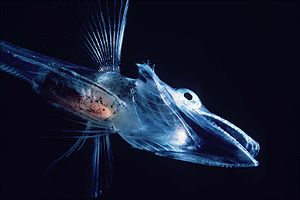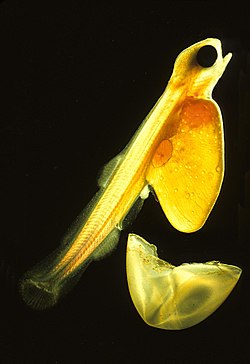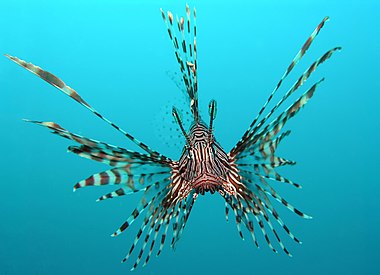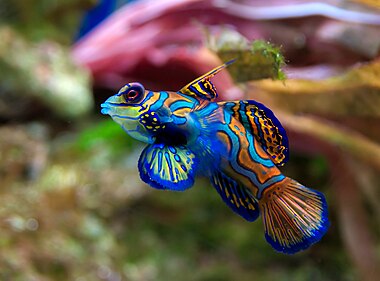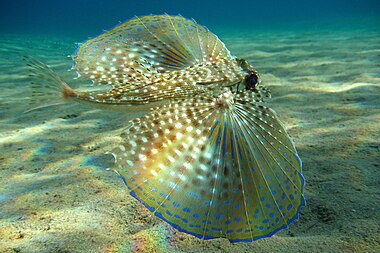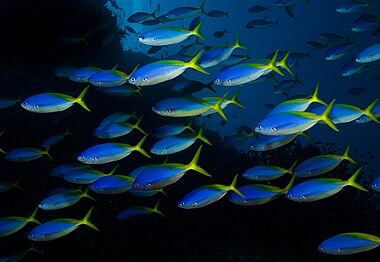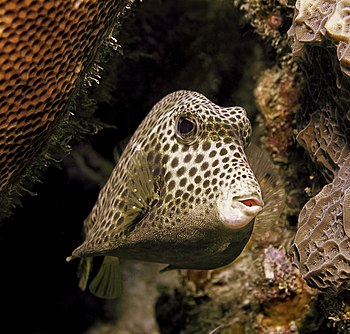Documentation
The Selected picture box on the portal chooses one of the following at random when displaying the page. Follow the instructions below for adding or nominating a new picture to the list.
Feel free to add related featured pictures to the list. Nominate other pictures on the portal talk page.
- Pictures must be
- Free to use and hosted on Commons
- Of good quality (not blurred, grainy or discoloured)
- Interesting
- Relevant to an article or topic
To find appropriate pictures, use search box below:
- For pictures, which appeared as picture of the day on the Main Page, just add the date in
YYYY-MM-DD format to the list (please keep the list sorted).
- For other pictures, use following parameters:
|iN=
|titleN=
|creditN=
|captionN=
where N is the next unused number.
List of selected pictures
[edit]Template:POTD/2004-07-28
Template:POTD/2007-01-04
Template:POTD/2007-06-04
The
Oscar (
Astronotus ocellatus) is a species of
fish from the
cichlid family. In
South America, where the species occurs, they are often found for sale as a food fish in the local markets. The species is also a popular
aquarium fish. They have been reported to grow to a length of 45 cm (ca. 18 in) and a mass of 1.6 kg (3.5 lb).
Template:POTD/2008-04-18
Template:POTD/2008-06-02
Template:POTD/2008-10-13
Template:POTD/2008-11-19
Template:POTD/2009-11-28
The
leopard shark (
Triakis semifasciata) is a species of
hound shark found along the
Pacific coast of
North America from the U.S. state of
Oregon to
Mazatlán in Mexico. Typically measuring 1.2–1.5 m (3.9–4.9 ft) long, this slender-bodied shark is characterized by black saddle-like markings and large spots over its back.
Template:POTD/2011-07-17
People
jigging—
fishing with a type of
lure known as a "jig"—for
squid in
Queenscliff, Victoria, Australia. A jig consists of a lead sinker with a hook molded into it and usually covered by a soft body to attract fish. Jigs are intended to create a jerky, vertical motion, as opposed to
spinnerbaits which move through the water horizontally.
Template:POTD/2012-02-14
The
Peacock flounder (
Bothus mancus) is a species of
lefteye flounder found widely in relatively shallow waters in the
Indo-Pacific. This
photomontage shows four separate views of the same fish, each several minutes apart, starting from the top left. Over the course of the photos, the fish
changes its colors to match its new surroundings, and then finally (bottom right) buries itself in the sand, leaving only the eyes protruding.
Template:POTD/2012-03-16
The
Atlantic spadefish is a species of marine fish
endemic to the shallow waters off the coast of the southeastern United States and in the
Caribbean Sea. They are similar in appearance to
fresh water angelfish, but much larger, reaching up to three feet (0.9 m) in length. Due to their reputation as strong fighters, they are popular
game fish, especially during the summer months when they are most active.
Template:POTD/2012-04-09
A plate with
fossils of
Pseudostacus sp. (lobster, left) and
Diplomystus birdii (fish, right), from the
Hakel paleontological formation in Lebanon. The
paleontological sites of Lebanon contain deposits of some of the best-preserved fossils in the world, and include some species found nowhere else. The most famous of these is the Lebanese
lagerstätten of the Late
Cretaceous age.
Template:POTD/2012-11-10
Template:POTD/2013-01-24
A sketch of a
longnose sawshark (
Pristiophorus cirratus), a species of
sawshark found in the eastern Indian Ocean around southern Australia on the
continental shelf at depths of between 40 and 310 m (130 and 1,020 ft). It is a medium-sized shark with a saw-like flattened snout which measures up to thirty percent of its body size.
Template:POTD/2013-04-16
The
Eurasian ruffe (
Gymnocephalus cernua) is a species of freshwater fish found in temperate regions of Europe and Asia. The aggressive fish is known to reproduce rapidly, leading to problems when it is introduced to foreign bodies of water.
Template:POTD/2014-06-19
Bryaninops yongei is a
benthic species of
goby widely distributed throughout the tropical and subtropical waters of the
Indian Ocean; it is commonly found living in and around coral. Although this species was discovered in 1906, its ability to propel itself quickly to escape predators makes it difficult to study.
Template:POTD/2014-11-28
The
orbicular batfish (
Platax orbicularis) is a
batfish endemic to the Indian and Pacific Oceans. It has a thin, disc-shaped body, and male can grow up to 50 centimetres (20 in) in length. In the wild, the orbicular batfish lives in
brackish or marine waters, usually around reefs, at depths from 5 to 30 metres (20 to 100 ft). It is also a popular aquarium fish, although captive specimens generally do not grow as long as wild ones.
Template:POTD/2016-06-15
The
flying gurnard is a fish of
tropical to warm temperate waters on both sides of the
Atlantic Ocean. When excited, it spreads its "wings", semi-transparent appendages tipped with a phosphorescent bright blue coloration which are used to frighten predators.
Template:POTD/2017-03-15
Template:POTD/2017-04-05
Template:POTD/2017-05-30
Template:POTD/2017-08-22
Template:POTD/2020-01-14
Rhinogobius flumineus, also known as the lizard goby, is a species of
goby in the family
Oxudercidae endemic to Japan, seen here in
Hamamatsu,
Shizuoka Prefecture. A small freshwater fish found in fast-flowing streams, it maintains its position against the current by gripping a rock with a sucker formed from two of its fins. The fish's mouth is slightly asymmetric; dextral (right-sided) fish tend to curve their bodies to the right as they rest, while sinistral (left-sided) fish tend to adopt a left-curving posture. The fish are omnivorous, picking edible items off the stream bed with the side of the mouth, but dextral and sinistral fish show no preference for which side of the mouth they use for this purpose.
Template:POTD/2020-08-02
The
spotted trunkfish (
Lactophrys bicaudalis) is a species of
ray-finned fish in the family
Ostraciidae, native to the
Caribbean Sea and parts of the western Atlantic Ocean. Members of this family are known as boxfishes because they have a hard outer covering consisting of hexagonal, plate-like scales fused together into a solid, triangular or box-like
carapace. Because of this casing, the body of the spotted trunkfish is not flexible, and locomotion is normally limited to slow movements performed by rippling its
dorsal and
anal fins and gently beating its
pectoral fins. If faster motion is required, it can additionally use its
caudal fin for propulsion. This spotted trunkfish was photographed at a depth of about 40 ft (12 m) at Bari Reef,
Bonaire.
Template:POTD/2020-11-13
The
round ribbontail ray (
Taeniura meyeni) is a species of stingray in the family
Dasyatidae, found throughout the nearshore waters of the tropical
Indo-Pacific region. Reaching 1.8 m (6 ft) across, this large ray is characterized by a thick, rounded pectoral fin disc covered by small
tubercles on top, and a relatively short tail bearing a single venomous spine. The ray is well-camouflaged when lying on the seabed; it is largely nocturnal, and preys on
molluscs,
crustaceans and
bony fish. Mature females bear litters of up to seven pups, which are fed during gestation on "uterine milk", a product secreted by the walls of the
oviduct. This round ribbontail ray was photographed in
Lakshadweep, India.
Template:POTD/2021-08-04
Photograph credit: Rickard Zerpe Brachysomophis cirrocheilos, the stargazer snake eel, is a marine fish belonging to the family
Ophichthidae. It is native to shallow tropical and subtropical waters in the western Indo-Pacific region. It hunts at night for
crustaceans and small fish, after which it submerges itself into the sediment tail first and remains there all day, with just its eyes and the top of its head projecting, as seen here in
Batangas Bay in the Philippines.
File:Psetta maxima Luc Viatour.jpg
File:Australian blenny.jpg
File:Schlammspringer fg01.jpg
Mudskippers, such as this
Periophthalmodon septemradiatus, are uniquely adapted to a completely amphibious lifestyle. They are active when out of water, feeding and interacting with one another, as well as defending their territories.
File:Kaimanfische (Lepisosteus).jpg
In
American English, the name
gar (or
garpike) is strictly applied to members of the
Lepisosteidae, a family including seven living species of fish in two genera that inhabit fresh, brackish, and occasionally marine, waters of eastern
North America,
Central America, and the
Caribbean islands.
File:DiskuslaichaS.jpg
A
discus (
Symphysodon discus) is guarding its eggs. As for most
cichlids, brood care is highly developed with both the parents caring for the young. Additionally, adult discus produce a
secretion through their skin, off which the
larvae live during their first few days.
File:Balistapus undulatus (Nausicaä).jpg
File:Flounder_camo_md.jpg
File:Seahorse Skeleton Macro 8 - edit.jpg
File:Hungry koi.jpg
Koi are ornamental domesticated varieties of the
common carp Cyprinus carpio, originated from
China and widely spread in
Japan. They are very closely related to
goldfish. The word "koi" comes from
Japanese meaning "
carp".
File:Chaetodon melannotus edit4.jpg
File:Pennant coralfish melb aquarium edit2.jpg
File:Isurus oxyrinchus Machoire.jpg
File:Longnose batfish.jpg
File:Koi feeding, National Arboretum.jpg
File:Chain moray eel.jpg
File:Astronotus ocellatus.jpg
File:Icefishuk.jpg
File:Thrissops cf formosus 01.jpg
File:Platax Orbicularis in the Egyptian Red Sea.jpg
File:Canthigaster valentini 1.jpg
File:Spotted Trunkfish.jpg
File:Hippocampus hippocampus (on Ascophyllum nodosum).jpg
File:Zebrasoma flavescens Luc Viatour.jpg
File:White shark.jpg
File:Gymnocephalus cernuus Pärnu River Estonia 2010-01-06.jpg
File:Georgia Aquarium - Giant Grouper.jpg
The
giant grouper (
Epinephelus lanceolatus), shown here with a school of
golden trevally, is the largest
bony fish found in
coral reefs, and the aquatic emblem of
Queensland, Australia. The species can grow as large as 2.7 meters (9 ft) long, weighing up to 400 kg (880 lb). They are fairly common in shallow waters and feed on a variety of marine life, including small
sharks and juvenile
sea turtles.
File:Arnoglossus laterna larva.jpg
File:HM Orange M Sarawut.jpg
Photo by Daniella Vereeken The
Siamese fighting fish (
Betta splendens), or
fighting betta is a
freshwater fish related to the
paradise fish. The fighting fish is a species in the
Gourami family which is popular as an
aquarium fish. They are called
pla-kad (biting fish) in
Thai or
trey krem in
Khmer. They are a very territorial fish and it is unwise to house two males together. Even the females may become territorial towards each other if not housed in a large enough tank.
File:MC Rotfeuerfisch.jpg
File:Paracirrhites forsteri Forsters Hawkfish juvenile Papua New Guinea by Nick Hobgood.jpg
File:Flughahn.jpg
File:Snowflake moray in Kona.jpg

